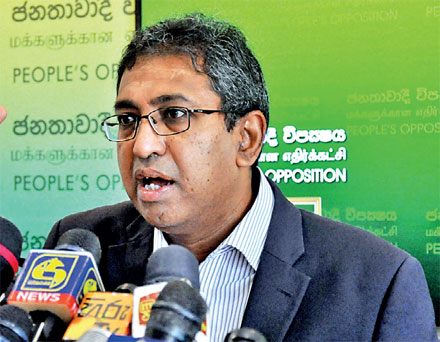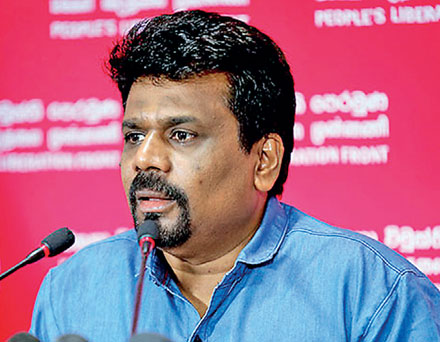Saturday Dec 27, 2025
Saturday Dec 27, 2025
Thursday, 18 August 2022 00:20 - - {{hitsCtrl.values.hits}}

Harsha de Silva

Anura Kumara Dissanayake
|
“JVP Support Surges with the Collapse of the Economy and the
Gotabaya Presidency…Today, the JVP leader would probably win a Presidential
Election…”
– Dr. Ravi Rannan-Eliya –
 The quote above from Dr. Ravi Rannan-Eliya’s newspaper article this week presenting his IHP team’s SLOTS tracker findings is a blockbuster. The IHP data further shows that:
The quote above from Dr. Ravi Rannan-Eliya’s newspaper article this week presenting his IHP team’s SLOTS tracker findings is a blockbuster. The IHP data further shows that:
“…as the government disintegrated and as the economic situation deteriorated, most of these predominantly Sinhala voters came off the fence and picked the NPP/JVP…It [is] doing better than the SJB in winning over Sri Lankans who voted for Gotabaya and the SLPP or SLFP back in 2019/20. The NPP/JVP is also winning over voters who opted for Sajith in 2019…The NPP/JVP is in the ascendant…”
(Full report: file:///C:/Users/news/Downloads/SLOTSReport202208%20(1).pdf.)
It was on 31 August 2014, on the fortnightly TV show Sithijaya on which I was the ‘talking head’ for five years, that I was the first to publicly urge Anura Kumara Dissanayake to run for President (Dr. Dayan Jayatilleka about Anura Kumara Dissanayake – YouTube). I also argued that the best thing from the perspective of economic development would be for Sajith Premadasa to be UNP leader, candidate and President. There was no contradiction. I didn’t expect AKD to win at the imminent election (2015) but urged a strong left alternative and was convinced that were he to run, he would, like Brazil’s Lula and Mexico’s Lopez Obrador (AMLO), eventually win.
Now seems to be the right time for the Left, not least because the SJB’s economic troika has eschewed the [Ranasinghe] Premadasa political economy and development paradigm, dismissed social democracy (which Sajith Premadasa had committed to) and launched a Ranil-friendly, technocratic, neoliberal ‘shock therapy’ blueprint.
It is an irony of history though, that precisely when there is a real prospect of AKD being elected Sri Lanka’s first leftwing President, buttressed by or buttressing a JVP-NPP victory at a parliamentary election, he and his party stand for the abolition of the executive presidency.
AKD and his party must grasp that just as there is a strong dynamic (e.g., ‘Pink Tide 2.0’) of leftwing, left-populist or social democratic electoral victories in the context of economic constriction and austerity, exceedingly few (Labour in Australia, New Zealand) were won by one left/progressive political party on its own or with an auxiliary (e.g., NPP), but only as part of a broad left and progressive front. The JVP/NPP cannot go it alone and win. In the global South, nobody has, because nobody can.
Great (insane) expectations
If the definition of insanity (attributed to Einstein) is to keep doing the same thing and expecting a different result, it is no less insane to keep expecting to be pulled out of the economic abyss by a combination of the same people who put us into it.
The present dispensation is a combination of the Rajapaksa administration which wrecked the economy since 2019, and Wickremesinghe and his economic proteges (including the SJB’s economic trio) who did so during the predecessor Yahapalanaya administration.
The SJB’s Dr. Harsha de Silva disclosed that he not merely supports President Wickremesinghe’s economic policy doctrine as recently enunciated in the Address to the Nation, but that it was the self-same doctrine that was worked out between 2014 and 2017 by a team which they were all on. That economic doctrine crashed the UNP and Prime Minister Wickremesinghe just as it did on the previous occasion he was elected PM in 2001-2003. As respected economic researcher Sunil Bastian argued in the aftermath, it wasn’t only the Ceasefire agreement with Prabhakaran but the impact of the neoliberal economic model that ensured Ranil Wickremesinghe wasn’t re-elected in 2004 (actually, for 15 years after his 2001 election).
The FSP’s educational secretary Pubudu Jayagoda pinpointed the excessive liberalisation of Exchange Control Regulations by Prime Minister Wickremesinghe in 2017 as the reason for the continuing outflow of export earnings of hard cash at this time of a deadly deficit of foreign exchange.
The JVP-NPP’s leader Anura Kumara Dissanayake followed this up with a bombshell during the Parliamentary debate of President Wickremesinghe’s Address to the Nation with the revelation that while the overwhelming bulk of Sri Lanka’s external debt was incurred by borrowings not from states or multilateral agencies but from the private international money-markets, the overwhelming bulk (80%) of those borrowings were not by President Mahinda Rajapaksa but by Prime Minister Ranil Wickremesinghe in 2015-2019.
|
Biased blueprint
Dr. Harsha de Silva, the main Opposition party the SJB’s chief economist so to speak, has just launched a 16-page document under his name, under the title ‘Blueprint: Out of the Debt Trap & Towards Sustainable Inclusive Development’. It has a strap that reads ‘A Ten-Point Common Minimum Program for Sri Lanka’s Economic Recovery’.
I’m no economist but as a student of comparative international politics I can easily recognise in Harsha’s document a policy template first applied in Indonesia after the coup by General Suharto and the massacre of one and a half million people, and then by Milton Friedman’s ‘Chicago boys’ after General Augusto Pinochet’s murderous military coup in Chile.
It is denounced in Latin America as “El Modelo”, the neoliberal model, which had caused so much misery and inequality that it had triggered popular uprising after uprising and finally generated two electoral tidal-waves, known as Pink Tide 1.0 and Pink Tide 2.0, throughout the continent. During the massive street protests that brought law student Gabriel Boric, Chile’s newly elected (35-year-old) President to national prominence and placed a new people-driven Constitution on the agenda, a frequent slogan was “Neoliberalism was born in Chile and will die in Chile!” The recent election of Colombia’s first leftwing President, a former rebel of the crushed urban guerrilla group M-19, is the latest victory in Pink Tide 2.0. In October, Lula could be re-elected Brazil’s President.
Here are some highlights of Harsha’s blueprint:
1. “The exchange rate should be carefully floated to market levels” … “a transitional phase of floating the currency to permit market forces to reveal the equilibrium rate…”
2. “…Forex restrictions on current account transactions, quantitative import restrictions…must be removed.”
3. “Land and labour market reform will enable and amplify this growth…”
4. “Urgent steps must be taken to create an efficient labour market by enacting new legislation…
5. “Labour protection should take the form of unemployment insurance rather than archaic labour laws” …
“Replace Termination of Employment of Workmen Act (TEWA) with an Unemployment Insurance Fund”.
Clearly the proposals would weaken the rupee, and facilitate the outflow of foreign exchange at a time when the country can least afford it.
Harsha’s blueprint is aimed at a fundamental shift in the economy between (a) the national and foreign, (b) the state and the market, (c) the public sector and private sector, and (d) the working people plus middle classes, and big capital, local and foreign.
This blueprint uses the current crisis to push through a wish-list of so-called economic reforms that the Sri Lankan public has always resisted and prudent rulers have hesitated to proceed with. Among other things it aims to repeal the centrepiece of the protection of the rights of working men and women. If this is a system-change, it is change for the worse—a conversion to untrammelled “capitalisme sauvage” (savage capitalism).
The ‘land and labour market reform’ spoken of here would shift the already unequal balance between the peasantry and corporate farming, local and foreign, in favour of the latter, as well as that between labour and capital also in favour of the latter.
The land market reform conceptualised in the blueprint is a clear negation of President Premadasa’s major policy initiative to address the state’s excessive ownership of land as a result of the unfinished Land Reforms of 1972 and 1975 which vested lands in the state without addressing the problem of landlessness. In early 1990 Premadasa appointed the first ever Presidential Task Force in Sri Lanka, named the Presidential Task Force for Land Redistribution. It earmarked 750,000 hectares of state-owned land to be transferred to the landless for purposes of cultivation or house building. 350,000 hectares had been distributed to the landless at the time of President Premadasa’s assassination by the LTTE, leaving 450,000 to be distributed.
The UNP administrations of Prime Minister Wickremesinghe (2001-2003 and 2015-2019) never undertook that task with any degree of purposiveness. Completing the program may have saved the UNP from electoral extinction and retarded the SLPP super-surge of 2019-2020.
The replacement of the Termination of Employment of Workmen Act would reduce the job security and bargaining power won by labour, while big capital would remain protected, thereby helping reduce the share of the national income that accrues to labour while enhancing that which accrues to capital. It is a unilateral tearing up of a Social Contract that has prevented violent class struggles in Sri Lanka.
The Harsha blueprint harshly rebukes the policies of many post-Independence administrations. It lightly pats on the back the liberalisation of 1977 and 1988, dropping heavy hints that it just wasn’t good enough because it just didn’t go far enough. It praises policy reforms attempted in 2003 and 2016—years in which Prime Minister Ranil Wickremesinghe held office. There is no similar commendation of the major ideas and programs of Ranasinghe Premadasa. Indeed, his development paradigm is not mentioned, still less commended; his export-led industrialisation drive, the 200 garment factories program –with its start-up state loans, guaranteed minimum wage, working conditions and meals—fails to earn a shout-out.
|
Repressive Ranilonomics
In his rollout of the blueprint at a media briefing, Dr. Harsha de Silva stressed that “we support President Ranil Wickremesinghe’s economic policy”. The next day he replied testily to the media that yes indeed, he thinks the President can solve the economic crisis because “he will remain the President for the next 2½ years.”
By endorsing Ranil’s 2½ year term, Harsha dismisses the declarations signed by unprecedentedly large numbers of Sri Lankan academics based here and overseas, as well as the stand of the JVP, FSP and IUSF, about the fundamental moral and ethical illegitimacy –as distinct from narrow Constitutional legality—of the Ranil presidency. Entrenching the incumbent President rather than according him a nightwatchman’s role of several months, deprives any package arrived at with the IMF and the creditors, of the safety-net of public consent obtainable only by a popularly-elected leader.
Dr. Harsha de Silva is a sincere opponent of repression. He does not understand the logic of his preferred economic model, as his guru Ranil Wickremesinghe always did. The model requires coercion to pre-empt or hold down the inevitable blowback, especially in a country with the democratic, social welfarist ethos of Sri Lanka.
This was first experienced and understood in Latin America. Perhaps the continent’s greatest contemporary political writer, Uruguay’s Eduardo Galeano (1940-2015) summed it up searingly in his indelible text ‘Cemetery of Words’:
“The only thing that’s free are prices. In our part of the world, Adam Smith needs Mussolini. Freedom of investment, freedom of prices, freedom of exchange: the greater the freedom for business, the more people are imprisoned. Who has heard of wealth being innocent? When there’s a crisis, don’t liberals become conservatives, conservatives fascists? Who do the murderers of people and countries work for?” (Cemetery of Words (sagepub.com)
The logic of the political economy of the model that Harsha has downloaded is that harsh repression inevitably precedes, parallels or follows its implantation. Economic liberalism needs political authoritarianism. To paraphrase Eduardo Galeano, in our part of the world, Ranil Wickremesinghe and Harsha de Silva need Kamal Gunaratna and Nissanka Senadipathi.
|
Alternatives abdicate, arrive
After the Hartal of August 1953 and the UNP government’s return under the hawkish Sir John Kotelawala (with Ranil’s father as advisor), the elite failed to understand what had just happened; what had irreversibly changed. It didn’t understand that having been saved from one kind of revolution it would inevitably be overthrown by another. When the results of the first post-Hartal national election came in, beginning with ex-communist Nimal Karunatilaka’s victory in Matale, the landslide became legend: ‘the Silent Revolution of 1956’.
Sinhala literary giant Martin Wickremasinghe hailed it as “the downfall of the Brahminic caste” (“bamunu kulayey binda vateema”). The elite did not figure that this time the masses no longer perceived the election as a chance to throw the ruling party rascals out, but as the conclusion of the August 1953 Hartal; the completion of an unfinished revolution against an entire social class or elite Establishment. If SWRD Bandaranaike and the SLFP had not been in position, it is the Marxist Left that would have completed the task—without refraction through the prism of Sinhala racism.
A similar tectonic shift of social consciousness has taken place with the Aragalaya. The public perceives the President and Parliament as representing an oligarchic constellation of two clans (Rajapaksas and Jayewardene-Wickremesinghes) and their satellites, coagulating into a single political Establishment or power-elite, irrespective of formal, increasingly nominal separation as Government and Opposition.
With the bipartisan convergence on neoliberal economic shock therapy, the political elite has revealed itself as the twin of the economic elite; the political establishment as symbiotic with the economic establishment.
Throughout the world, the citizen-majorities are seeing through the lie that “There Is No Alternative” (‘TINA’) – the basis of the harsh Harsha blueprint—and perceiving that systemic priorities can be re-set, with the concept “People’s Security” (Juan Somavia, UN World Social Summit, Copenhagen, 1995) as the core of a “needs-based” macroeconomic policy.
The people are turning against the old Establishment, towards the populist-left/left-populism or social democracy. In Sri Lanka that could have been the centre-left populism of a Premadasist SJB, but it seems to have surrendered that space and re-entered the ideological force-field and diminished electoral enclave of generic UNP-ism under pressure from the party’s economic Rightwing.
How can an Opposition function effectively while echoing the economic doctrine of the country’s ruler during an economic crisis, rather than presenting a progressive alternative to it?
Harsha’s blueprint signals that the SJB is pivoting/has partially pivoted to a path of doctrinal, political and eventual electoral convergence with the UNP – a reunification of the Right, doubtless prescribed by the International Republican Institute (IRI) at a recent conclave. Abdication of the moderate-progressive centre and a political realignment and policy integration of the neoliberal Right during an economic meltdown and austerity program, automatically devolves the role and function of mainstream alternative on the JVP-NPP.
Going by the opinion-polls, Sri Lankans are making a rational choice: if the crisis is going to get worse and the options going to get tougher, they prefer not to bandwagon with the Ranil-UNP-SJB Right, but rather, to leverage AKD and the JVP-NPP to balance, buffer and hedge.
It’s not that the public rejects the IMF, but they cannily want the IMF plus the JVP. They are increasingly turning left and want the JVP-NPP in their corner as governance option, because they trust it more than anyone else in this Parliament to safeguard their rights and socioeconomic needs and interests.